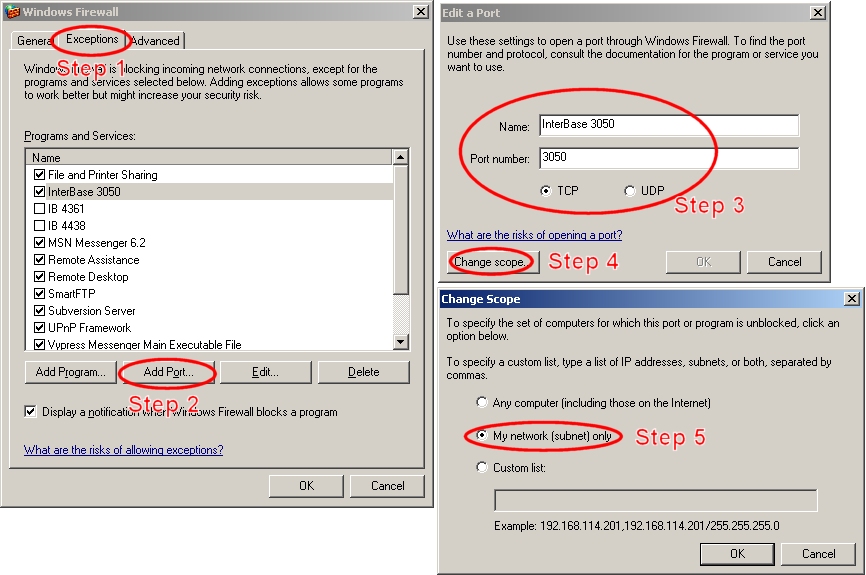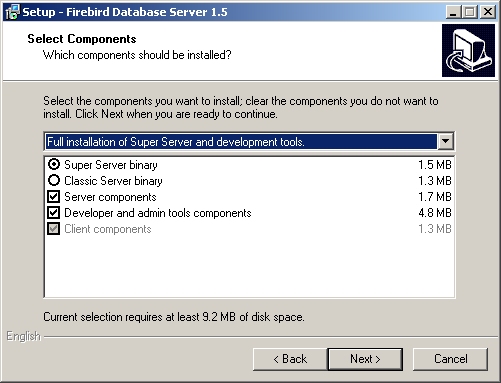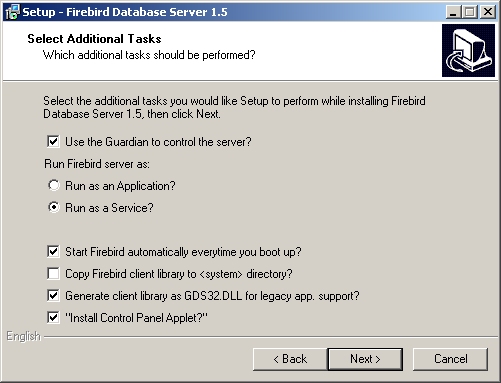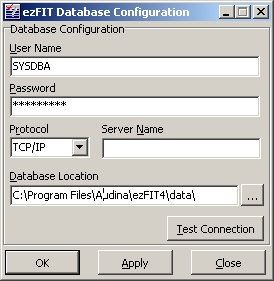This is an old revision of the document!
Installation Requirements
2013
Hardware
- 1.6 GHz Processor.
- 2 GB of RAM.
- Serial port or USB port (when using a USB port, you also need a USB-Serial Adapter to connect to a Hi-Pro programming box).
- 250 MB of free hard disk space.
Software
- Windows XP-SP3/2003/Vista/2008/7/8 (Professional or Server) for the server installation.
- Windows XP-SP3/Vista/7/8 for the client installation.
- Drivers for USB-Serial Adapter (if using a USB serial port to connect to a Hi-Pro programming box).
4.x
Hardware
- 900 MHz Processor.
- 128 MB of RAM.
- Serial port or USB port (when using a USB port, you also need a USB-Serial Adapter to connect to a Hi-Pro programming box).
- 30 MB of free hard disk space.
Software
- Windows 2000/XP/2003/Vista (Professional or Server) for the server installation.
- Windows 98/ME/2000/XP/2003/Vista for the client installation.
- Drivers for USB-Serial Adapter (if using a USB serial port to connect to a “Classic” Hi-Pro programming box).
Installing from CD-ROM
Stand-alone Version
- Place the ezFIT software CD into CD-ROM drive. The CD menu should start automatically, showing the ezFIT software installation, product catalog, and more.
- If the CD does not start automatically, do the following:
- On the Windows desktop, click on Start > Run.
- Type:
D:\start.exe(assumingD:is the CD-ROM drive letter).
- To install the ezFIT software, click on 'Software Installation'. At the next screen, click on 'Install Software'. During the installation process, any data from the earlier version of ezFIT (patient data, fittings) will be incorporated into this new version.
- Click on the ezFIT icon on the Windows desktop to start using ezFIT today!
NOAH Version
- Place the ezFIT software CD into CD-ROM drive.
- Run Noah on your system.
- Install the fitting module by following the appropriate instructions specific to your Noah version:
- From within Noah 2.0
- Select from menu: Setup > Install Module
- Type:
D:\(assumingD:is the CD-ROM drive letter)
- From within Noah 3.0
- Select from menu: Tools > Setup > Install Module
- Press button: <Install New Module>
- Find and select installer in CD-ROM:
D:\install.ini - Find and select installer in folder where the files are:
- For example:
D:\install.ini
Reminder: Updates are always available at http://www.audina.net
Downloading and Installing from Internet
Stand-alone Version
- Download a copy of ezFIT Stand-alone from http://www.audina.net
- Run the downloaded installer and follow instructions on the screen.
NOAH Version
- Download a copy of ezFIT for NOAH from http://www.audina.net
- Copy the downloaded ezFIT software into a folder on your hard drive. For example:
C:\TEMP - Unzip the file by double-clicking on the ezfit4-noah.exe file. It will extract the following files to the current folder (for example:
C:\TEMP):INSTALL.INI- Installer script file.NHSETUP.EXE- Packaged software (do not execute directly).
- Run Noah on your system.
- Install the fitting module by following the appropriate instructions specific to your Noah version:
- From within Noah 2.0:
- Select from menu: Setup > Install Module
- Type the drive and folder name (full path) where the unzipped files are. For example:
C:\TEMP
- From within Noah 3.0:
- Select from menu: Tools > Setup > Install Module
- Press button: < Install New Module >
- Find and select installer in folder where the unzipped files are: For example:
C:\TEMP\install.ini
Reminder: Updates are always available at http://www.audina.net
Network Installation
A typical network has a server and one or more client machines. 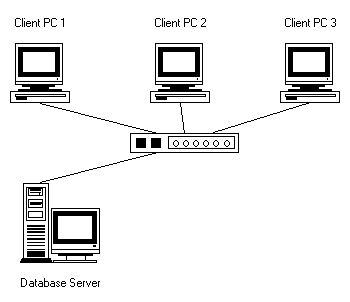
We need to install a database server on the server machine, then install the ezFIT software on the client machines. Perform the following steps:
On the Server
- Open Firewall port 3050 for Firebird. In Windows XP with SP2, the following steps apply to configure the Windows Firewall:
- Go to Control Panel (Start > Control Panel).
- Open Windows Firewall.
- Add a new Port (press “Exceptions” tab, then “Add Port…” button).
- Name: Firebird
- Port Number: 3050
- TCP
- Place the ezFIT software CD into CD-ROM drive. The CD menu should start automatically, showing the ezFIT software installation, product catalog, workshop information and more.
- If the CD does not start automatically, do the following:
- On the Windows desktop, click on Start > Run.
- Type:
D:\audina.exe(assumingD:is the CD-ROM drive letter).
- Click on “Software Installation” to show the next screen.
- Click option “Database Server” to install it on the server machine.
- Write down name of the server. Look it up in Start > Settings > Control Panel > System > Computer Name > Change.
- Open database server port 3050 on the server firewall (and in each client machine having a firewall). If using Windows XP (SP2), perform the following steps:
- Go to Start > Settings > Control Panel > Windows Firewall > Exceptions.
- Click on < Add Port >. Name: “Firebird 3050”, Port Number: 3050, Protocol: TCP.
Note:
You must configure the client on the server as well, if you wish to use that as a workstation. Failure to do so will block other clients from sharing the database.
On each Client computer
- Place the ezFIT software CD into CD-ROM drive. The CD menu should start automatically, showing the ezFIT software installation, product catalog, and more.
- If the CD does not start automatically, do the following:
- On the Windows desktop, click on Start > Run.
- Type:
D:\audina.exe(assumingD:is the CD-ROM drive letter).
- Click on Software Installation to show the next screen.
- Run option to install “ezFIT Stand-alone” on all the client machines (When using NOAH, refer to Installing ezFIT for NOAH instead).
- Configure each client machine to point the database path to the server.
- In ezFIT, go to Tools > Options > Database.
- Database Location:
server_name_here: C:\Program Files\audina\ezFIT4\data\('server_name_here' is the name of your server)
- Alternatively, you can perform the same configuration, but using the ezFIT Backup Utility (from the Windows Desktop: Start > Programs > Audina ezFIT > ezFIT Backup Utility).
- Go to Database > Database Configuration.
- Protocol: TCP/IP
- Server Name:
server_name_here
Note:
You must configure the client on the server as well, if you wish to use that as a workstation. Failure to do so will block other clients from sharing the database.
Installing Programming Box Drivers
Hi-Pro driver installation
For Hi-Pro USB
- Install the drivers first (Warning: do not plug in the Hi-Pro USB yet!). Insert Hi-Pro driver CD into your CD-ROM drive and run setup.
- Select “Hi-Pro USB driver”.
- When prompted to do so, connect the USB cable.
- When the “Found New Hardware Wizard” shows up:
- Select “No, not this time” option under “Can Windows connect to Windows Update to search for software?”, then click < Next >.
- Select “Install new software automatically [Recommended]” option and click < Next >.
- Click on < Continue Anyway > button if the screen “This hardware has not passed Windows Logo testing to verify its compatibility with Windows” appears.
- Configure a HI-PRO USB to use any of these ports: COM1, COM2, COM3, COM4.
Warning:
The “Found New Hardware Wizard” will appear twice, and you need to follow the same steps listed above.
For "Classic" Hi-Pro (Serial connection only)
- Insert ezFIT installation CD into your CD-ROM drive and browse the drive.
- Run ezFIT installation.
Warning:
When using a new notebook computer, it will not have a serial port available. Purchase a USB-Serial Adapter and install it in the available USB port.
* More details: Installation USB Serial Adapter
MicroConnect Card (MicroCard) driver installation
- Insert ezFIT installation CD into your CD-ROM drive and browse the drive.
- Right-click the file “Microconnect.inf” and select “Install”.
DSP Programmer driver installation
- Disconnect DSP Programmer from computer.
- Download a copy of ARKbase framework from
Gennum: http://www.gennum.com/hip/software/Sound Design Technologies: http://www.sounddesigntechnologies.com/software/arkbase.php - Install downloaded file.
- Connect DSP Programmer to USB port in your computer.
- Allow MS Windows to detect and install the drivers for the new hardware.
- Reboot your computer.
Warning:
Make sure you do not connect the DSP programmer before installing the ARKbase software. If you do, then disconnect it and cancel the Windows auto-detection of new hardware. You might need to go to Control Panel > System > Harware > Device Manager to remove it from “Other Devices”. This category contains all the devices detected but not yet installed, usually due to lack of drivers. Reboot after this and proceed with driver installation as outlined above.
